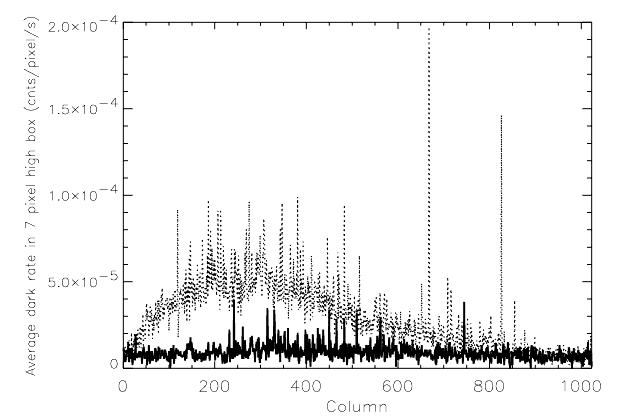



The FUV MAMA suffers from an irregular dark glow that varies unpredictably in intensity. When this glow is absent, the typical dark rate of the FUV MAMA detector is about 6x10-6 cnts/pixel/s. When the glow is strong, it can enhance the dark current to as much as 1x10-4 cnts/pixel/s over a large fraction of the detector. For first order spectra, the best way to minimize this extra dark current is to put the target at a location on the detector where the extra dark current is small.
For first order spectra of faint sources less than about 1" in angular extent, we recommend that this be done by placing the target about 2" above the bottom edge of the FUV MAMA detector. Since for the G140L and G140M the locations where the regular aperture positions project onto the center of the detector are already displaced about 3" below the center (in order to avoid the shadow of the FUV MAMA repeller wire), this requires an additional displacement of about -6.8" in the cross dispersion, or y, direction. This can reduce the extra dark current by up to a factor of 6 (see Figure 2.1). The instrument calibrations may not be quite as accurate at this position as they are at the center of the detector. Background subtraction may also be more difficult due to the proximity to the edge of the detector. Therefore, use of this position is recommended only for objects sufficiently faint that the FUV MAMA dark current is the major limitation on the achievable accuracy.
The D1 apertures listed in the Table 2.1 will be supported for first order spectroscopic ACCUM or TIME-TAG observations with the G140L and G140M. The 52X0.1D1 and 52X0.05D1 are also supported for CCD ACQ/PEAK observations. Note that the 25MAMAD1, F25QTZD1, and F25SRF2D1 aperture locations are intended only for first order FUV MAMA slitless spectroscopy. Users who wish to offset faint imaging targets to avoid the worst of the FUV dark current should look at Figure 7.18 or consult with a STScI Instrument Scientist via help@stsci.edu.



|
Space Telescope Science Institute http://www.stsci.edu Voice: (410) 338-1082 help@stsci.edu |